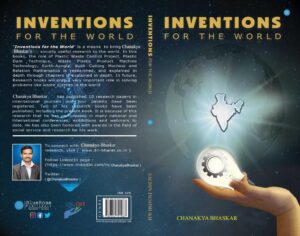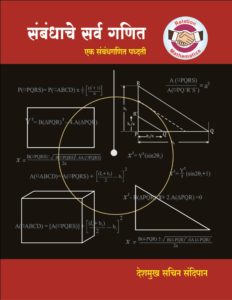
BOOK – Inventions for the World
Author’s Name : Chanakya Bhaskar
Title’s Name : Inventions for the World
ISBN : 978-93-5668-418-8
Finish Size/ Book size : 5*8
Paperback MRP : Rs.325
Binding : Paperback
Lamination on Cover : Matte
Orientation : Portrait
Text Pages/ Page count : 256
Cover Paper : 230 GSM C1S
Language : English
Audience : Adult/ Children/ General
Text Color (Color or Black & White) : Black and White
Text Paper/ Paper quality : Natural Shade 60 GSM


Book Available on
<-- Amazon , Flip kart, Blue rose etc. -->
Scan and buy the book.

About the Author
Chanakya Bhaskar has been dedicatedly advancing research, ideas, and concepts through his book “Inventions for the World.” Concurrently, he serves in a governmental capacity, contributing to national service. This remarkable journey commenced in 2008, resulting in four registered patents, along with the publication of ten research papers in esteemed international journals. A notable accomplishment includes the composition of “The Great Method of Relation All Mathematics,” a Marathi publication exploring “Relation Mathematics.”
The foundation of these accomplishments lies in optimal conditions, time allocation, and unwavering support, all orchestrated to align with the betterment of both the nation and the global community. Overcoming diverse challenges has emerged as a priority in these pursuits. Chanakya remains confident that his research endeavors will serve as a guiding light in the times ahead.
Central to his work is addressing the escalating issue of plastic pollution, both in India and worldwide. With a focus on environmental and ecological repercussions, two key research avenues have been pursued: Plastic Dam and Waste Plastic Product Machine (WPPM) Technology. The Plastic Dam innovation showcases a transformative solution, positively impacting plastic pollution, water conservation, and empowerment, devoid of air, water, or land contamination.
Parallelly, the WPPM technology aims to convert plastic waste into useful products through innovative processing methods. This technology adapts to available resources, contributing to plastic waste management. Noteworthy progress has been made, with the intention of disseminating these breakthroughs via the Plastic Waste Control Project (PWCP) and Clean City Model. Within the context of India’s extensive efforts towards cleanliness, the PWCP is poised to serve as a definitive strategy, particularly in addressing non-biodegradable waste, a substantial impediment to waste management systems.
Simultaneously, Chanakya has embarked on an extensive exploration of “Relation Mathematics,” aligning with the Plastic Waste Control Project. This research initiative has yielded eight research papers published in renowned international journals, accompanied by the publication of “The Great Method of Relation All Mathematics” in Marathi, released on December 22, 2015. The primary objective underlying this venture is to popularize social mathematics across diverse demographics and age groups. Chanakya seeks to elevate this mathematical research under the revised subject of “Relation Mathematics,” underpinned by the innovative concept of “Side-measurement.” Anticipating its transformative impact on society, this work is poised to emerge as an all-encompassing guide for years to come.
Notably, the book expounds upon additional research concepts, including the assertion that “The Earth is not round in shape; it assumes the form of an Earth-angle.” Furthermore, the “Bush Cutting Machine” concept finds elucidation within these pages. With unwavering confidence, Chanakya anticipates these research endeavors will illuminate pathways for substantial future accomplishments.
Presenting the culmination of a decade-long pursuit, Chanakya takes pride in sharing the book “Inventions for the World.” This confluence of research, dedicated to societal betterment, stands as an open platform, devoid of expectations for personal gain. Chanakya holds steadfast in his conviction that this book holds paramount importance, offering guidance for current and future research endeavors on a global scale.
About the Book
Chanakya Bhaskar is brimming with delight as he presents the book “Inventions for the World,” a repository of comprehensive research poised to benefit the global populace. This endeavor encompasses a range of significant research areas, notably the Plastic Dam Technique, Waste Plastic Product Machine (WPPM) technology, Relational Mathematics, and various other explorations. Chanakya is keen to extend his heartfelt gratitude to the invaluable supporters who have steadfastly championed these research endeavors. Their unwavering backing has been instrumental in realizing the culmination of this book.
The initial five chapters of “Inventions for the World” stand as a testament to relentless research and arduous labor, dedicated to resolving the pervasive issue of plastic pollution on a global scale. These chapters present compelling solutions to confront the pressing challenge of plastic pollution. Chanakya, in his pursuit, has seamlessly integrated mathematical research with his initiatives in plastic waste management. The focal point remains the dissemination of the groundbreaking concept of “Relational Mathematics” to the broader world. A Marathi publication titled “Sambhadhache Sarva Ganit, Ek Sambhandha Ganit Paddhati,” released on December 22, 2015, serves as the cornerstone of this endeavor. Additionally, eight research papers derived from this work have garnered recognition through publication in esteemed international journals. The sixth chapter, a succinct English expansion, encapsulates the essence of this mathematical innovation, aptly titled “The Great Method of Relation All Mathematics.” The subsequent chapters, spanning mechanical and astronomical explorations, delve into the “Bush Cutting Machine” and challenge conventional notions about Earth’s shape.
The author’s ongoing engagement with diverse research topics, resonating with the thematic underpinning of this book, underscores a relentless pursuit of knowledge. The ninth chapter meticulously outlines the author’s proactive efforts to disseminate research through multifaceted channels, encompassing media, conferences, exhibitions, and interactions with VIPs. The tenth chapter features insightful quotes from Sachin Deshmukh, which further enrich the scholarly discourse. Beyond being a writer, Chanakya Bhaskar epitomizes the spirit of a dedicated researcher, a facet evident in the culmination of this book.
“Inventions for the World” is not merely a book but a compendium of rigorous research. Its narrative promises to usher in a transformative impact, particularly in combatting the pressing challenge of plastic pollution. Furthermore, it promises to illuminate unexplored horizons of knowledge. The writer is confident that this scholarly endeavor will catalyze an unparalleled revolution on the global stage. In closing, heartfelt appreciation is extended to all those who have embraced this research book.
[Note: – “Inventions for the World” serves as a conduit for ongoing research efforts by Chanakya Bhaskar. As future research evolves or transforms, subsequent editions of this book will duly reflect these advancements.]
Key Points about the Book “Inventions for the World” and Author Chanakya Bhaskar:
* Comprehensive Research: The book “Inventions for the World” by Chanakya Bhaskar is a culmination of extensive and diverse research endeavors spanning several significant fields.
* Global Relevance: The research presented in the book addresses pressing global challenges, with a primary focus on plastic pollution and its impact on the environment.
* Plastic Pollution Solutions: The initial chapters of the book delve into innovative solutions, such as the Plastic Dam Technique and Waste Plastic Product Machine (WPPM) technology, aimed at combating plastic pollution and conserving resources.
* Mathematical Innovations: Chanakya Bhaskar seamlessly integrates mathematical research into his initiatives, particularly in the realm of “Relational Mathematics,” with the goal of making this innovative concept accessible to a broader audience.
* Publication and Recognition: The author’s Marathi book “Sambhadhache Sarva Ganit, Ek Sambhandha Ganit Paddhati,” released on December 22, 2015, serves as a cornerstone, accompanied by the publication of research papers in international journals.
* Multidisciplinary Exploration: Beyond plastic pollution, the book covers a spectrum of subjects, including mechanical and astronomical research, challenging conventional notions about Earth’s shape, and introducing concepts like the “Bush Cutting Machine.”
* Research Dissemination: The author actively seeks to disseminate research through various channels, including media, conferences, exhibitions, and interactions with VIPs, aiming to create widespread awareness and impact.
* Scholarly Impact: Chanakya Bhaskar’s dedication to research extends beyond writing; his work exemplifies a researcher’s spirit, evident in the depth and breadth of exploration.
* Transformative Potential: “Inventions for the World” is not just a book but a compendium of transformative potential. It is poised to contribute significantly to global issues like plastic pollution while fostering new realms of knowledge.
* Continuous Evolution: The book represents an ongoing journey, with the promise of subsequent editions adapting to evolving research, reflecting the author’s commitment to continuous advancement.
* Gratitude and Acknowledgment: Chanakya Bhaskar expresses gratitude to supporters and well-wishers who played an instrumental role in the realization and dissemination of the book’s research.
* Revolutionary Vision: The author’s visionary perspective anticipates a groundbreaking revolution sparked by the impact of “Inventions for the World.”
* Global Significance: The book’s comprehensive research and innovative insights are poised to influence and guide research initiatives worldwide.

I aim to introduce the subject of “Relation Mathematics” to a global audience. This emerging field offers innovative perspectives in the realm of mathematics, with its cornerstone being the seminal work titled “The Great Method of Relation All Mathematics.” Authored by myself, this book, written in Marathi, marks a significant milestone in the field of Relation Mathematics.
On December 22, 2015, coinciding with India’s National Mathematics Day, the book was unveiled. It has since garnered international attention, reflecting its profound insights and novel concepts. To date, eight research papers authored by me have been successfully published in esteemed international journals, further cementing the significance and relevance of this new discipline.
“Relation Mathematics” presents a unique opportunity for researchers, scholars, and enthusiasts to delve into uncharted territories within the mathematical landscape. This subject encompasses a range of interconnected mathematical relationships that have the potential to reshape our understanding of various mathematical phenomena.
By fostering exploration and investigation, “Relation Mathematics” paves the way for groundbreaking discoveries. Its application extends beyond traditional mathematical paradigms, inviting scholars from diverse backgrounds to contribute to its evolution. As a subject, it is primed to ignite the curiosity of mathematicians and learners worldwide, driving innovation and advancement in this dynamic field.
In essence, “Relation Mathematics” offers a gateway to a new realm of mathematical exploration, brimming with possibilities and awaiting the insightful contributions of mathematicians and thinkers from every corner of the globe.
*** About Relation Mathematics ***
I have introduced a new subject in mathematics called “Relation Mathematics” and published the first book titled “The Great Method of Relation All Mathematics.” Additionally, I’ve authored 8 research papers in international journals. On December 22, 2015, which is India’s National Mathematics Day, I released the book in Marathi language. Relation Mathematics offers a promising avenue for exploring novel mathematical concepts.
Published book - Relation All Mathematics
Email Id- relationmathematics@dri-bharat.co.in
“The first book on the subject of ‘Relation Mathematics’ is titled ‘The Great Method of the Relation All Mathematics.’ This comprehensive book introduces numerous relations, concepts, and theorems. Any future research connected to ‘Relation All Mathematics’ will inherently incorporate the essential elements of the ‘Relation Mathematics’ subject.”
“The Great Method of the Relation All Mathematics” has been published online in the Marathi language and is accessible through the provided link.
http://www.readwhere.com/publication/9916/Relation-All-Mathematics-
Relation All Mathematics

Mentioned Research Inside “Relation All Mathematics‟ Book :-
1. Chapter number 1 introduces the methodology of fundamental concepts.
2. Formulas elucidate the relationship between squares, rectangles, and two rectangles.
3. The connection between two right-angled triangles is established through formulae, accompanied by a proof of the Pythagoras theorem within the framework of “Relation All Mathematics.”
4. Within a right-angled triangle, the square of the hypotenuse is equated to the difference between the squares of the side measurements (b1+h1) and four times the area.
5. A novel quadratic equation formula is derived, relating to both rectangles and right-angled triangles. Notably, this formula is derived independently of the contemporary quadratic equation.
6. The relationship between cuboids and cubes is defined using pertinent formulas.
7. The practical application of the cuboid-cube relationship in the agricultural industry is explored.
8. The Pythagoras theorem is rigorously proven using the “Relation All Mathematics” approach in Topic no. 6.
9. Utilizing the relationship between two right-angled triangles, the interplay of hypotenuse, base, height, side measurements, and area is expounded, particularly under conditions of equal area and equal side measurements.
10. “Relation All Mathematics” constitutes an emerging field, introducing a spectrum of relationships through this research. Future studies related to this work inherently contribute to the advancement of the subject of “Relation Mathematics.”
[Note: The research has been ongoing since 2007 and continues to evolve.]
